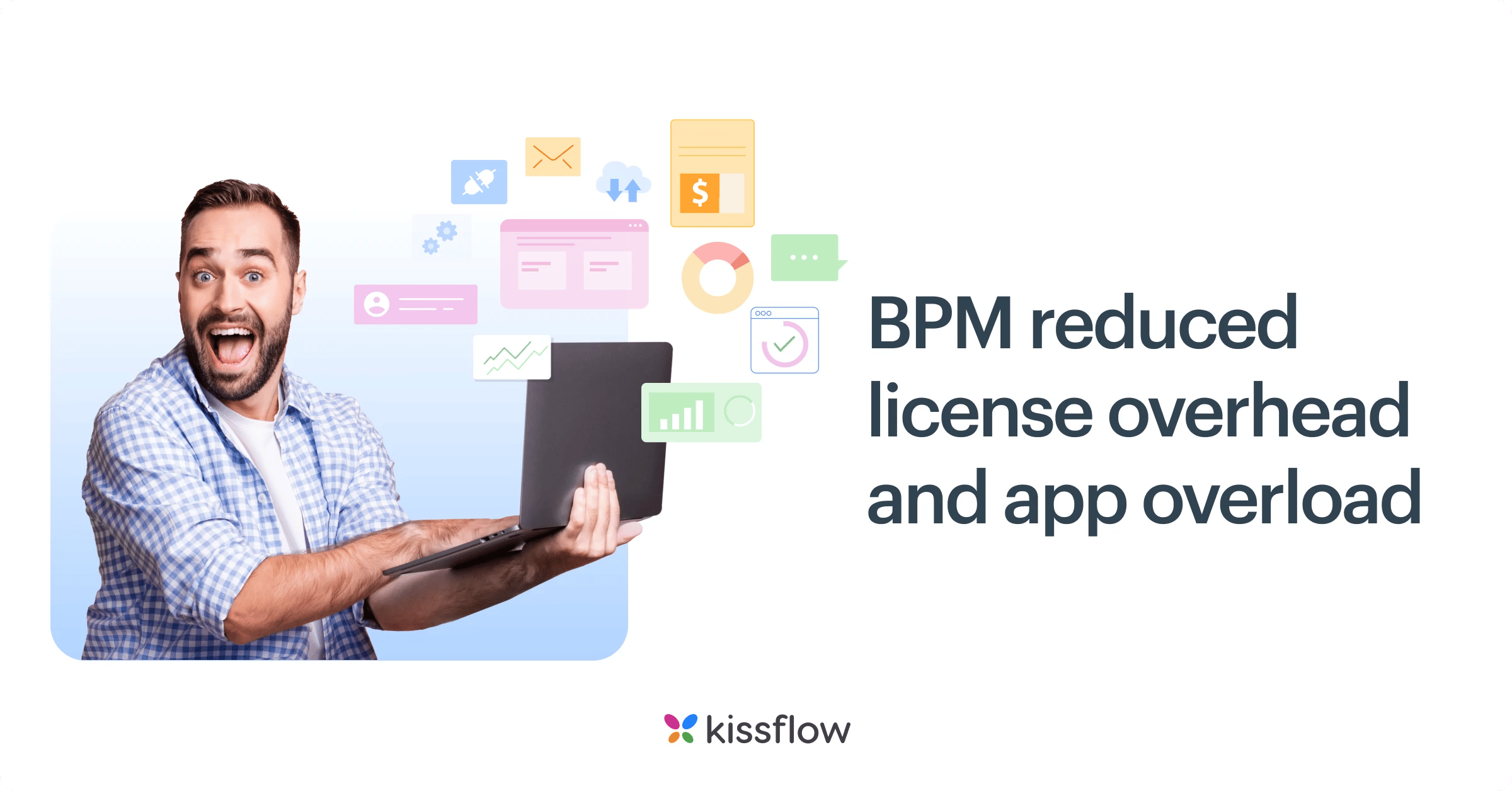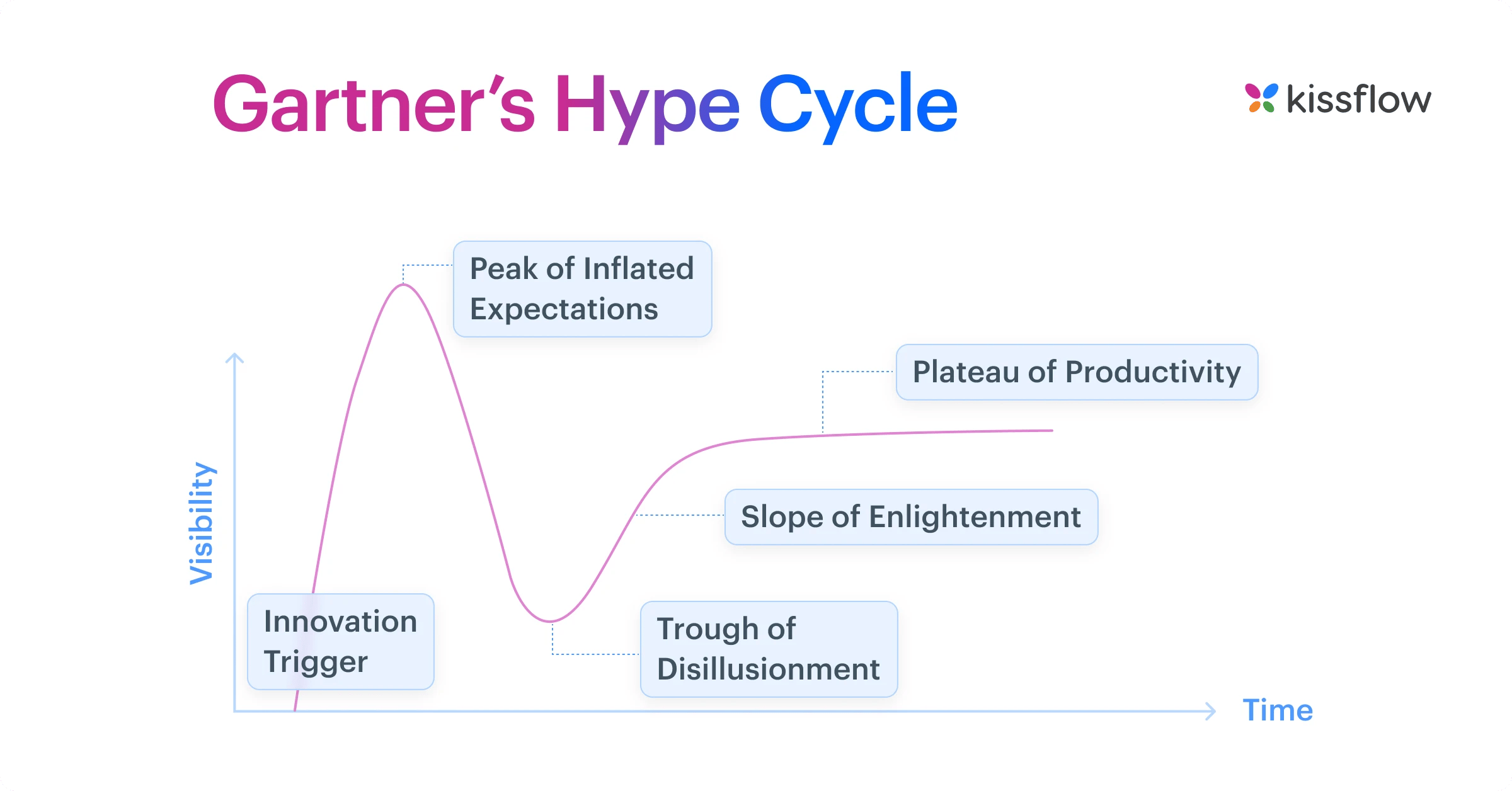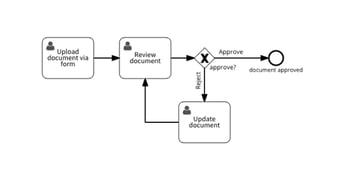
- >
- BPM Software >
- 11 Massive Benefits of Business Process Management (BPM) You Need to Know
11 Massive Benefits of Business Process Management (BPM) You Need to Know
Team Kissflow
Updated on 20 Jun 2025 • 8 min read
A report by Research and Markets says the global BPM market is expected to grow from $8,766 million in 2020 to $14,440 million by 2025.
But how does COVID-19 change everything? Will companies invest more or less in BPM?
According to this survey conducted in April 2020 to assess the impact of COVID-19 on businesses, 54 percent of enterprises are increasing investments in a process automation platform. Process automation is a main component of BPM.
The COVID-19 pandemic has only increased the need for a company-wide BPM platform. When companies adopt BPM seriously, they experience bountiful benefits in their businesses.
With BPM tools, enterprises can establish a systematic approach for optimizing and managing business processes. These tools enable business users with little to no coding experience to build workflows and connect disparate processes.
For CIOs planning to achieve complete digital transformation, understanding the advantages of business process management (BPM) is critical—BPM can digitize processes across the organization, decrease IT costs, increase agility, and improve overall efficiency by involving business users and IT teams in the digitization initiatives.
General Benefits of Business Process Management
Business Process Management (BPM) streamlines operations, increasing efficiency, reducing costs, and improving productivity. The advantages of BPM also include helping identify bottlenecks, fostering collaboration, and enhancing decision-making, leading to organizational competitiveness and growth.
According to John Stretton, Associate Director of Process Automation at EDP Renewables. “Well-designed BPM systems play a key role in minimizing growing pains by helping employees navigate complex processes, increasing visibility into work queues, preserving and organizing institutional knowledge, and reducing reliance on email-based processes.
Top 11 benefits of Business process management (BPM)
Here are the top 11 benefits of Business Process Management that help organizations streamline their processes.
1. Increased productivity
BPM helps the entire organization construct solid frameworks for all its processes. All important processes are documented, monitored, and optimized when processes function in full swing with very few hiccups and process efficiency increases.
Process analysis is carried out constantly. Tasks that add no value are easily identified and eliminated, leading to an overall increase in productivity.
2. An agile organization
With proper BPM implemented in an organization, teams are more flexible to changes. Teams know their processes well and why they work like they do. When there is a solid understanding of processes, explaining to teams the why and how of a new change is easy.
Course correction is easier since the process roadmap is clear. Any changes can be easily pinpointed and adopted quickly.
An organization that is flexible to changes is very powerful. It can navigate any problems caused by internal or external factors and exponentially increase results. By leveraging the advantages of BPM, teams become more scalable, competitive, and collaborative.
3. Reduced errors
In primitive tools like spreadsheets and emails, errors are almost inevitable. There’s no way to ensure data stays updated and who does what.
Errors are also impossible to track when processes are managed in spreadsheets. Errors occur frequently when processes have no stakeholders for each step. Employees habitually tossing stuff over the wall without taking responsibility for tasks.
With good BPM practice, the possibility of errors is greatly reduced. Stakeholders are informed of their duties in each step and ensure they meet the defined criteria. If errors occur, they can be traced back to the source easily.
4. Ensured policy compliance
Adopting BPM is a one-shot approach to streamline processes and implement a framework to comply with all internal and external policies. BPM makes sure that the processes are well understood and follow strict guidelines.
There are multiple industry and department-specific policies to comply with. For example, procurement and HR teams have totally different internal policies to comply with. One of the key benefits of BPM is that it enables both teams to comply with their respective policies within the same tool.
In Kissflow Process, you can track SLAs and be notified whenever they are near the point of breach. Each process has metrics to keep tabs on requests in each app.
5. Reduced micromanagement
Micromanagement might get the job done at that instant. But in the long run, it is always destructive for a company. One of the primary reasons why leaders tend to micromanage their teams is to stick to their methods to reduce errors.
BPM eliminates the need for micromanagement. All standard operating procedures are documented clearly by the leaders and employees educated about their duties. When it’s time for a particular step, employees execute the task with clarity without hand-holding or instructions each time.

Unlock the Power of Comprehensive BPM Tools: Scale, Succeed, and Stay Ahead
Thank you for downloading!
6. Controlled data accessibility
For employees to work efficiently, they need access to data from different sources. But it doesn’t mean they need to access anything and everything. Giving access to unnecessary information also causes confusion and delays.
BPM is the best tool to strike the balance between data overload and insufficiency. You can control the accessibility of data required to complete a particular task and choose to hide the rest.
In Kissflow Process, you can assign users to different user groups according to teams. This lets you control what data they can access and edit.
7. A company-wide platform
The right BPM tool can act as a central platform to fetch and push data to core software systems like ERP and CRM. Usually, department-specific software is built for unique use cases. Accessing data and using it for other activities can be difficult.
Integration of core software with a company-wide BPM platform unveils many benefits. Among the key benefits of BPM are the ability to automate processes that don’t require human intervention, reduce manual entries, and shorten cycle times.
If all employees are made users in such a BPM platform, everyone has access to the company’s core operations. They have the appropriate level of access to information in different systems.
8. Digital transformation
Digital transformation is no longer a new term. A major component of digital transformation is bringing in organizational stability and adaptability with digital tools and practices.
Leveraging no-code BPM platforms in your digital transformation efforts is very important. After you determine your organization’s goals for the next 2-3 years, you can use BPM as an instrument to build processes that help you to achieve those goals.
Employees analyze what’s best for their teams, and build their own solutions which in turn helps drive digital transformation.
Read more about how BPM takes a central role in digital transformation here.
Bonus!
Here are some benefits of BPM that are not directly observed as results.
9. Reduced license overhead and app overload
Employees use multiple tools. They retrieve and upload data between software systems all the time.
According to this survey, the average number of apps used by an employee is 9.39. 70% don’t care what app they use until they get access to the information. 67% believe it would be easier to focus on work if important information from all of their apps appeared in a single window.

An ideal BPM platform aids in retrieving and updating data in different apps. Apart from employees, vendors and customers also benefit from a BPM platform.
With Kissflow Process, information from external users can be collected with public forms. You can automate data collection in your ERP systems without adding each vendor as a user on the platform. The same applies to collecting data from customers or leads and updating CRMs.
10. Identified strengths and skill gaps
Processes are merely ways of coordinating people, skills, capabilities, and behavior with other systems and resources to drive the right business outcomes. With BPM comes constant monitoring of processes.
BPM can signal you about skill gaps in employees. When a process always gets stuck in a particular step with a particular person, it might be a red flag for an unskilled worker. This is common in support and finance teams where employees are not fully aware and trained in certain protocols.
When a particular step in a process is always quick in execution and error recovery, it is a sign of good employee skills and performance. Note that this is only possible in human-centric BPM where the platform is built for human-centric processes.
11. A single adoption curve
With the introduction of every new product, there is a new way of work. Gartner’s hype cycle explains the sequence of events that a team undergoes during the adoption of a new product.
The time taken to reach the plateau of productivity varies for each application. Some are easy to adopt, some are not. It depends on the bandwidth of the solution you implement.

Think about the amount of effort you put in to implement multiple point solutions in different departments. Each solution has its own adoption time. You need to sail through the whole curve each and every time you buy new software to accommodate a process.
With a no-code BPM platform, the time taken to reach the plateau of productivity might be higher. But the adoption is strong and productivity is increased by the time you finish. You don’t need to think about implementing another solution anytime soon.
Example of business process management: Employee onboarding
For many organizations, employee onboarding can be a complex process involving multiple departments like IT, HR, and Compliance. With BPM, you can build, automate, and optimize the entire employee onboarding process.
You can streamline approvals and automate repetitive tasks like new account setup and background checks. It's also possible to set up processes for new employees to complete required forms, track the progress of their onboarding, and access company documents they need to get started.
More importantly, BPM can make it easier to scale the onboarding process and accommodate variations.
Achieve business process management with low-code
Low-code development platform support BPM strategies with greater flexibility and governance. A low-code platform like Kissflow offers a visual drag-and-drop editor to transform processes into streamlined workflows with minimal coding and IT costs.
A simple yet powerful low-code tool, Kissflow supports collaborative development and encourages business users to become a part of the development process. Solve your workflow challenges with Kissflow platform and optimize your team's productivity.
FAQ- Advantage of BPM
1. What is Business Process Management (BPM)?
Business Process Management (BPM) is a systematic approach to improving and optimizing an organization's workflows and processes for better efficiency and performance.
2. Why is Business Process Management important?
BPM is important because it helps organizations streamline operations, reduce inefficiencies, improve productivity, and achieve business goals more effectively.
3. What are the key benefits of Business Process Management?
The key benefits of BPM include improved efficiency, enhanced agility, cost savings, better compliance, and superior customer satisfaction.
4. How does Business Process Management improve efficiency?
BPM improves efficiency by automating repetitive tasks, identifying bottlenecks, and streamlining workflows, which reduces time and resource wastage.
5. What tools are used for Business Process Management?
Tools like workflow management software, low-code platforms, and process analytics tools are commonly used for BPM to design, monitor, and optimize processes.
6. How does Kissflow support Business Process Management?
Kissflow provides a comprehensive BPM platform that helps organizations automate, monitor, and optimize their business processes for enhanced efficiency and agility.
7. What are the 5 stages of BPM?
The five stages of BPM are design, model, execute, monitor, and optimize. First, the process is mapped out and structured (design and model). Then it’s implemented (execute), tracked for performance (monitor), and improved based on insights (optimize).
8. How does BPM improve organizational efficiency?
BPM improves organizational efficiency by standardizing processes for consistent outcomes, eliminating redundant steps and bottlenecks, clarifying roles and responsibilities, providing visibility into process performance through metrics, enabling continuous improvement through data-driven analysis, facilitating cross-functional coordination, and creating the foundation for effective automation of routine activities.
9. What are the financial benefits of BPM?
Financial benefits of BPM include reduced operational costs through elimination of redundant steps and manual work, faster process cycle times improving cash flow, decreased error rates reducing rework costs, improved compliance reducing risk and potential penalties, optimized resource allocation, enhanced customer satisfaction driving revenue growth, and greater agility to respond to market changes.
10. How does BPM support digital transformation?
BPM supports digital transformation by providing the operational backbone for digital initiatives, enabling process standardization before automation, creating visibility into performance through metrics, facilitating the transition from manual to automated work, ensuring consistent customer experiences across channels, and providing the agility to continuously adapt processes as digital capabilities evolve.
11. What industries benefit the most from BPM?
Industries benefiting the most from BPM include financial services (loan processing, compliance management), healthcare (patient journeys, insurance coordination), manufacturing (production workflows, quality management), government agencies (citizen services, regulatory compliance), and logistics companies (supply chain optimization). Any organization with complex, cross-functional processes gains significant value.
12. How does BPM improve decision-making?
BPM improves decision-making by providing accurate, real-time data on process performance, establishing clear decision criteria through business rules, ensuring consistent application of policies, creating visibility into bottlenecks and inefficiencies, enabling simulation of process changes before implementation, facilitating collaboration across departments, and creating closed-loop feedback for continuous improvement.
Say no to chaotic work. Automate your tasks now.
Related Articles











%20(1)%20(1).png?width=1997&height=1800&name=The%20ultimate%20buyers%20guide%20to%20BPM%20(1)%20(1)%20(1).png)
